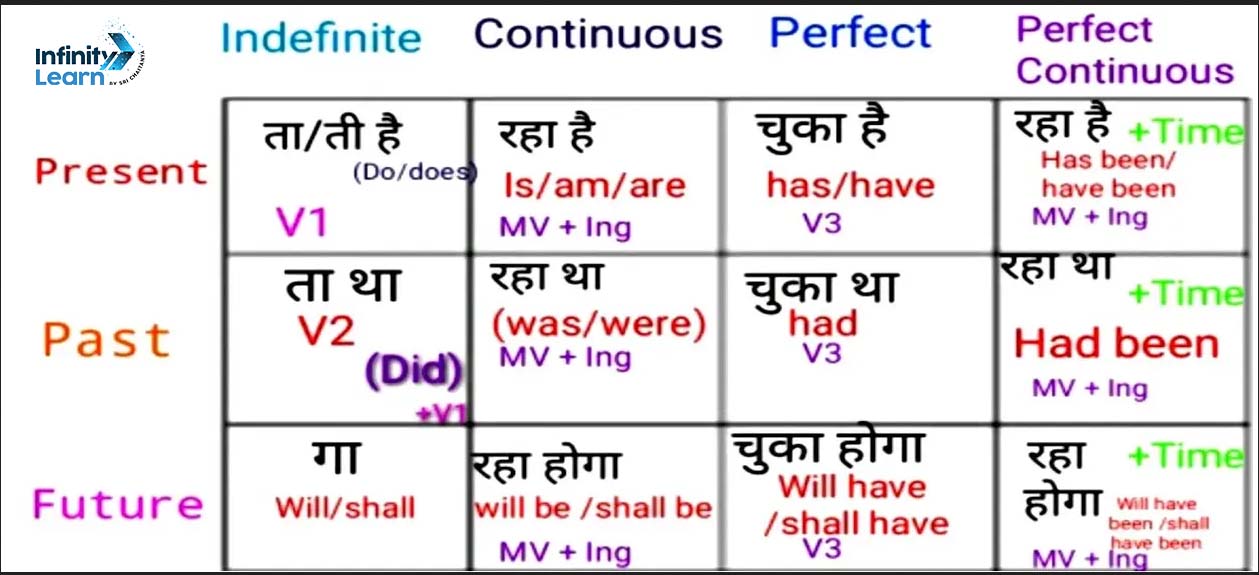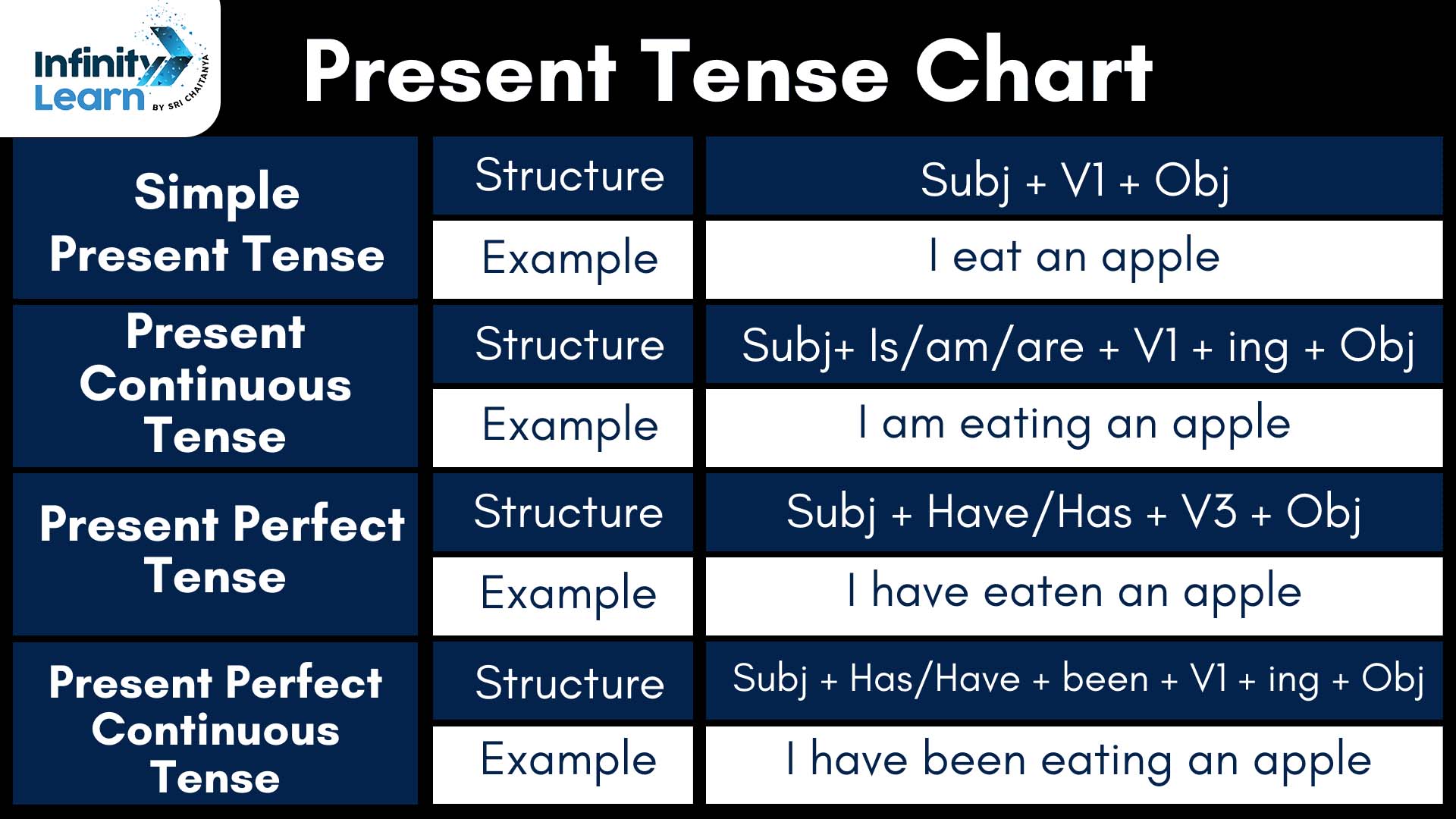Table of Contents
Tense Chart- Tense forms are generally 3 types(present, past, and future) which consist of Four types of tenses each. Read the Tense Chart to know more about tenses.

A tense chart is a visual guide showing English tenses. It helps students learn how to use tenses correctly. There are 3 main tenses: present, past, and future. Each has 4 forms: simple, continuous, perfect, and perfect continuous.
Simple tenses for regular actions or general truths. Continuous for ongoing actions. Perfect for actions before a moment. Perfect continuous for ongoing past actions. Tense charts aid English grammar learning, making tense use clear and practical for students.
What is Tense?
Tense refers to the grammatical concept that indicates the time when an action, event, or situation takes place. In English and many other languages, verbs change their forms to express different tenses, helping us understand whether something is happening in the present, has already happened in the past, or will happen in the future. Tense allows us to describe the timing of actions and events accurately within a sentence.
Definition Of Tense
Tense Definition: In the Merriam-Webster Dictionary, ‘tense’ refers to verb forms indicating action time. Collins Dictionary describes it as verb forms revealing action time, and Cambridge Dictionary defines it as showing action time.
Tense chart in English
This article provides a comprehensive explanation of the Tense Chart in both English and Hindi. A Tense Chart is a valuable tool for students, helping them understand how verbs, or tenses, convey when events happen.
Tenses come in three types: present, past, and future, each with four subtypes: Simple, Continuous, Perfect, and Perfect Continuous. This article elaborates on tense charts, offering clear rules and examples.
Different Types of Tenses in English
In English grammar, there are 3 main tenses and they are each classified into 4 different forms which sum up to twelve tenses in total. The three tenses in English are-
- Past Tense
- Present Tense
- Future Tense
The 4 different forms of tense are-
- Simple Tense
- Continuous Tense
- Perfect Tense
- Perfect Continuous Tense
Tense Chart with Rules and Examples in English
| TENSE CHART | ||
| TENSE | FORMULA & RULES and EXAMPLE | |
| SIMPLE PRESENT TENSE | Subject + base form of the verb/verb+s/es(if needed) + rest of the sentence. | He takes oats for breakfast. |
| SIMPLE PAST TENSE | Subject + past form of the verb (verb 2) + rest of the sentence. | She went for a walk early in the morning. |
| SIMPLE FUTURE TENSE | Subject + helping verb(will) + base form of the verb+ rest of the sentence. | Jeffry will travel around the country in December. |
| PRESENT CONTINUOUS TENSE | Subject + am/is/are + present participle (verb+ing) + the rest of the sentence | I am watching television. |
| PAST CONTINUOUS TENSE | Subject + was/were + present participle (verb+ing) + the rest of the sentence | She was completing her work when her mother came back. |
| FUTURE CONTINUOUS TENSE | Subject + will +be + base form of the verb + the rest of the sentence | Children will be going to school. |
| PRESENT PERFECT TENSE | Subject + have/has + past participle (third form of the+ rest of the sentence. | I have worked as an educator for two years. |
| PAST PERFECT TENSE | Subject + had + past participle (third form of the verb) + rest of the sentence. | You had worked as a clerk for five years. |
| FUTURE PERFECT TENSE | Subject + Helping verbs (will + have) + third form of the verb + object. | I will have done this work before she comes. |
| PRESENT PERFECT CONTINUOUS TENSE | Subject + have/has + been + present participle (verb+ing) + since/for (if needed) + the rest of the sentence. | You have been telling the truth. |
| PAST PERFECT CONTINUOUS TENSE | Subject + had + been + present participle (verb+ing) + since/for (if needed) + the rest of the sentence. | I had been living at my uncle’s place. |
| FUTURE PERFECT CONTINUOUS TENSE | Subject + will have + been + present participle (verb+ing) + since/for (if needed) + object. | She will have been waiting here for three hours by seven o’clock. |
Tense Chart in Hindi

Chart of Tenses: Tense Table
| Base Form /V1 | Past Simple/ V2 | Past Participle /V3 |
| be (is, am, are) | was, were | been |
| begin | began | begun |
| bend | bent | bent |
| bet | bet | bet |
| bid | bid | bid |
| bite | bit | bitten |
| blow | blew | blown |
| break | broke | broken |
| burn | burned/burnt | burned/burnt |
| buy | bought | bought |
| catch | caught | caught |
| choose | chose | chosen |
| cut | cut | cut |
| dig | dug | dug |
| dive | dove | dived |
| do | did | done |
| draw | drew | drawn |
| fall | fell | fallen |
| feel | felt | felt |
| fight | fought | fought |
| find | found | found |
| forgive | forgave | forgiven |
| freeze | froze | frozen |
| get | got | gotten |
| give | gave | given |
| go | went | gone |
| grow | grew | grown |
| hang | hung | hung |
| have | had | had |
| hear | heard | heard |
| hide | hid | hidden |
| hit | hit | hit |
| hold | held | held |
| hurt | hurt | hurt |
| keep | kept | kept |
| know | knew | known |
| lay | laid | laid |
| lead | led | led |
| leave | left | left |
| lend | lent | lent |
| let | let | let |
| lie | lay | lain |
| lose | lost | lost |
| make | made | made |
| mean | meant | meant |
| meet | met | met |
| pay | paid | paid |
| put | put | put |
| read | read | read |
| ride | rode | ridden |
| ring | rang | rung |
| rise | rose | risen |
| see | saw | seen |
| sell | sold | sold |
| send | sent | sent |
| sing | sang | sung |
| sit | sat | sat |
| sleep | slept | slept |
| speak | spoke | spoken |
| spend | spent | spent |
| stand | stood | stood |
| swim | swam | swum |
| take | took | taken |
| teach | taught | taught |
| throw | threw | thrown |
| understand | understood | understood |
| wake | woke | woken |
| wear | wore | worn |
| win | won | won |
| write | wrote | written |
Present Tense Chart

Past Tense Chart

Future Tense Chart

FAQs on Tense Chart
What is a tense chart in English?
A tense chart in English is a visual representation that organizes verb forms according to different time frames, indicating when actions or states occur. It helps learners understand how verbs change to express different tenses – past, present, and future.
What are the 12 formulas of tenses?
The 12 formulas of tenses represent different verb forms to express various time aspects. They cover tenses like Simple Present, Present Continuous, Present Perfect, Present Perfect Continuous, Simple Past, Past Continuous, Past Perfect, Past Perfect Continuous, Simple Future, Future Continuous, Future Perfect, and Future Perfect Continuous.
How do you use tense charts?
Tense charts assist in selecting the correct verb form based on the time of the action or state. By locating the relevant tense on the chart, you can identify how to construct sentences with appropriate verb tenses.
What are the kinds of tense on chart paper?
Tense charts on paper typically categorize tenses into three main types: Present Tenses, Past Tenses, and Future Tenses. Under these categories, various specific tenses are displayed along with their corresponding verb forms.
What are the 4 types of tense with examples?
The four types of tenses are Present Tense, Past Tense, Future Tense, and Future in the Past Tense. Examples include: Present: She sings. Past: They played. Future: I will write. Future in the Past: He said he would come.
What are the 5 types of present tense?
The five types of present tense are Simple Present, Present Continuous, Present Perfect, Present Perfect Continuous, and Present Simple Passive. Examples include: Simple Present: He reads books. Present Continuous: She is eating dinner. Present Perfect: They have finished their homework. Present Perfect Continuous: I have been studying. Present Simple Passive: The book is read by him.
What is tense and its types?
Tense refers to the grammatical expression of the time of an action or state. Its types include past, present, and future tenses, each further divided into specific tenses to convey precise timing and duration.
How many tenses in English?
English has three primary tenses: past, present, and future. These tenses are further divided into multiple specific tenses, resulting in a total of 12 tenses.
What are the 4 types of past tense?
The four types of past tense are Simple Past, Past Continuous, Past Perfect, and Past Perfect Continuous. Examples include: Simple Past: She visited yesterday. Past Continuous: They were playing. Past Perfect: He had already left. Past Perfect Continuous: She had been reading.









